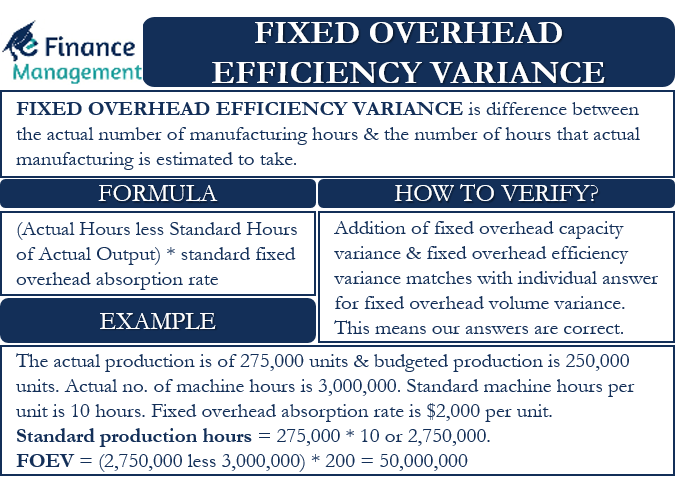Fixed Overhead Efficiency Variance (FOEV) is the difference between the actual number of manufacturing hours and the number of hours that actual manufacturing is estimated to take. To get the variance, we multiply it by the standard absorption rate per hour.
Fixed Overhead Efficiency Variance helps to verify the efficiency of labor. It does this by comparing the actual time it took the labor to finish one unit with the standard time to finish one unit.
This variance could be a result of many factors, including any sudden rise in inefficiency. This variance may also arise due to more break-time for employees, labor strikes, breakdown in plant or machinery, and more.
As to who can be held responsible for this variance, it is primarily the executives or department overseeing production operations. This is because this variance is attributable to the utilization of the input resources to get the output.
Relation with Fixed Overhead Volume Variance
FOEV is one of the parts of the Fixed Overhead Volume Variance. The other part of FOVV is the Fixed Overhead Capacity Variance (FOCV).
FOVV is the difference between the fixed overheads that a company actually incurs and the standard fixed overheads for the actual number of units. Similarly, FOCV is the variance that we get after subtracting the difference between budgeted fixed overheads and the fixed overheads applicable to the number of hours worked.
FOVV is the sum of both FOCV and FOEV.
Or, FOVV = FOCV plus FOEV
This means that if we have FOVV and FOCV, we can easily find the FOEV. For this, we need to subtract the FOCV from the FOVV.
Formula for Fixed Overhead Efficiency Variance
We can calculate the Fixed Overhead Efficiency Variance using this formula:
FOEV = (Actual Hours less Standard Hours of Actual Output) * standard fixed overhead absorption rate
Here, Standard Hours of Actual Output = Actual output * Standard working hours for making one unit.
FOEV can either be favorable or unfavorable (or adverse). The FOEV will be favorable if the actual hours for actual manufacturing are less than the standard hours for actual manufacturing. This means the company was able to produce more goods in less time.
There is one more formula to calculate FOEV, which involves using Fixed Overhead Volume Variance.
FOEV = Fixed Overhead Volume Variance less Fixed Overhead Capacity Variance.
Example of Fixed Overhead Efficiency Variance
The actual production for Company X is of 275,000 units, while the budgeted production is 250,000 units. Similarly, the actual no. of machine-hours is 3,000,000. And the standard machine hours per unit is 10 hours, while the standard fixed overhead absorption rate is $2,000 per unit.
To calculate FOEV, we will first have to find the Standard production hours.
Standard production hours = Actual production * standard hours per unit = 275,000 * 10 or 2,750,000.
We will also need a Fixed Overhead Absorption Rate per unit of the hour. This will be – fixed overhead absorption rate/ unit of hour = 2000/ 10 = 200 unit per hour
Now, we have to enter the values in the formula for FOEV.
FOEV = (2,750,000 less 3,000,000) * 200 = 50,000,000
FOEV here is unfavorable. The reason being the actual number of hours was more than the standard hours.

How to Verify?
We can also verify the above answer. As said above, FOEV is a part of the Fixed Overhead Volume Variance. So, if we add FOCV and FOEV, we should get the FOVV.
Now, we need to find the FOCV and the FOVV.
First, let’s calculate FOCV.
FOCV = (Budgeted Production Hours less Actual Production Hours) * Budgeted fixed overhead absorption rate per hour
For this, we need the budgeted production hours. For this, we need to multiply budgeted production with standard machine hours. It will be 250,000 x 10 or 2,500,000. Now put the values in the FOCV formula.
FOCV = (2,500,000 less 3,000,000) * 200 = 100,000,000
FOCV here is favorable. The manufacturing hours for Company X were more than the budgeted.
Now, we need to find the Fixed Overhead Volume Variance (FOVV). Formula for Fixed Overhead Volume Variance is:
FOVV = (Standard Hours * Fixed Overhead absorption Rate) Less Budgeted Fixed Overheads
Putting the values in the formula: FOVV = (275,000 x $2,000) less (250,000 x $2,000) = $50,000,000.
FOVV, in this case, is favorable.
Now, to verify the answers, we need to add the individual answers of FOCV and FOEV.
FOVV = $100,000,000 (F) plus $50,000,000 (U) = $50,000,000 (F)
So, the addition of FOCV and FOEV matches with the individual answer for FOVV. This means our answers are correct.
Final Words
Fixed Overhead Efficiency Variance, as the word suggests, tells about the efficiency in the use of resources. However, FOEV doesn’t offer enough information to help management make a meaningful analysis about the fixed production overheads. So for better decision making, it is always better to use the information from FOEV in combination with other fixed and variable variances.
RELATED POSTS
- Variable Overhead Cost Variance – Meaning, Formula, and Example
- Variance Analysis Formula with Example
- Fixed Overhead Calendar Variance – Meaning, Formula, and Examples
- Fixed Overhead Volume Variance
- Fixed Overhead Spending Variance – Meaning, Formula, Example, and More
- Production Volume Variance: Meaning, Formula, Limitations, and More

